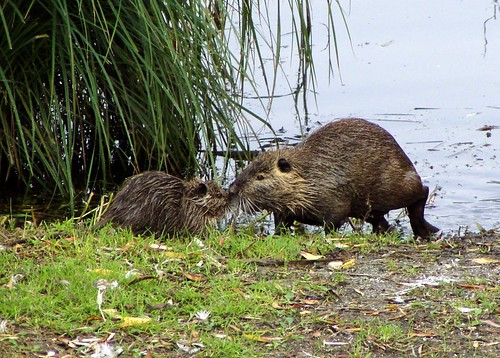Omnivore Discrimination & Fashion Pest Control
Two very interesting articles came to my attention today asking some complex questions - but don't think I didn't include a crafty response.

• The New York Times is reporting on a trend and organization called "righteous fur" that has designers using Nutria, - a beaver-sized, herbivorous rodent native to South America that was brought to the United States by fur farmers in the early 1800's after their own species was nearly driven to extinction in their native habitat. Now, with many Nutria having escaped, the invasive species is threatening the coastal ecosystem of Louisiana! What are ecologists to do? Turn them into fur coats, of course and throw a fashion show in Williamsburg, Brooklyn! Nothing could compete with the fashion industry's insatiable appetite for fur, or idiots looking for a rationalization to use it. After all, wearing fur makes you an environmental activist (just keep the whole cruel killing and toxic tanning process hush, hush). I'd like to follow this line of logic and ask why no BP executives have  been turned into fur coats either? Or what about developers? Apparently we're the only species allowed to destroy coastal ecosystems without the threat of being turned into garments.
been turned into fur coats either? Or what about developers? Apparently we're the only species allowed to destroy coastal ecosystems without the threat of being turned into garments.
Ok, ok, so the Nutria are being killed anyway to save the wetlands (I wonder what threatened industry is being helped under the guise of "saving the wetlands") and were being left to rot, so we may as well use them to make coats, right? Lets not feed them to natural, local predators like alligators or try a sterilization program. Lets follow this logic also - how come no one is using the 6 to 8 million dogs and cats that are euthanized every year in the United States - their fur is "wasted" too, no? And what about real NYC rats who are poisoned to death by the millions every year.
I guess the question is really, is fashion going to save the coastal wetlands from an invasive species? The answer is, no, it's not any more than people making earrings out of zebra-mussel shells will save aquatic systems overrun by them. Invasive species are an unfortunate and nearly unavoidable consequence of global trade. There is no easy solution, but there are certainly people looking to capitalize on the "guilt-free fur". The unfortunate part of this is that these designers forget that fashion is a powerful form of visual communication - and the message that most people will see is "fur is acceptable and cool" and that is all. Let's also remember that it was the fur industry that got those wetlands into this mess in the first place - is reinforcing a demand for fur going to solve it?
• Canada's National Post had a cover story on our friend and Discerning Brute, Inder Bedi of Matt & Nat, where a former employee (who chose to remain anonymous) attempted to file a humans rights case against the vegan company's no-meat policy at the office. Saying it's your human right to eat animals is like saying it's your human right to beat your kids. There are individuals who are injured and killed as a result of those actions, whose "rights" are never put into the equation in the first place. Is that too drastic? Ok, well there are certain things that are unacceptable in the work place. Masturbation, for instance, is not illegal, but in the context of a work environment, it is not considered good for business unless its a sex shop. In this case, eating meat at a vegan company's office is not socially appropriate. We live in a meat-dominated culture, and skipping meat for one meal a day is certainly not going to kill anyone (especially animals). My advice to the Anonymous Cry-Baby - get over it. You should be happy that a company like Matt & Nat has policies that protect the earth, the animals, and - whether you like it or not - your health. Go eat all the crap you want after work, masturbate and spank your kids, too.